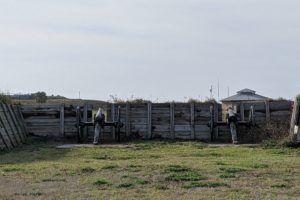Before we started this trip, Barney found out that Nevada provided survival guides booklets that highlight each town and what to see there. The guide has spots on each town’s page where someone from a designated travel spot stamp it. We ordered ours, and started having them stamped in Fallon and then in Austin. In Eureka, the owner of BJ’s Diner stamped our book. When we get stamps from 5 towns, we can send the passport back to the state and get a certificate that we conquered the loneliest road in the nation!

numbered roads; Nevada saw the marketing potential, and here we are!
The more I thought about it, the more I realized I wanted to say a little more about Eureka because of the great information in the town’s walking tour brochure. Eureka’s population at the last census was around 600, about double that of our last town, Austin.
Eureka is one of the best preserved mining camps in the West because of the 4 major fires that the town endured between 1876 and 1880. Each time the town rebuilt with thick-walled brick buildings with iron fire doors and installed hydrant systems throughout the town. They even built bigger and fancier structures, choosing to see that the fires as provided them with this opportunity. Such buildings include the Eureka County Courthouse, the Sentinel Building and the Opera House. Now we know that much of the town’s character that we saw as we drove through came from the fires that encouraged the town to rebuild.
mining
The Eureka Mining District was established in 1864 and is the birthplace of the silver-lead smelting industry in the U.S. From 1869 to 1879, the town was a major producer of domestic pig lead until it was overshadowed by Leadville, Colorado. Okay, I had to look up pig lead. It’s a larger “chunk” of lead typically purchased for remelt or as ballast., usually sold in 50-100 lb bars. Guess these bars were easier to transport.
Eureka’s ores, however, also contained precious metal. They built their own smelter so they wouldn’t have to send it to smelters in Salt Lake City (by train) and were very successful. Silver mining in this area boomed for a while but quickly ended. By 1885, most of the accessible high-grade ore had been mined, and the smelters stopped by 1891. WWI briefly started production again, but the production and prosperity never again got going. The era of Eureka’s silver boom was between 1870 and 1890.
town growth
Once smelting became profitable, the town really started growing. Tent and crude log cabins gave way to board and brick storefronts. By the mid-1860s, 250 buildings made up the town, many coming from other mining camps, and Eureka got a post office, always a symbol of prosperity. By this time the population had grown to 700.
With 5 years of continued growth and stability, Eureka claimed to be the second largest urban center in Nevada! By this time, the town had around 9000 residents, many of them Cornish and Irish immigrants to work in the mines.
mines and smelters
In 1878, Eureka was proud to have 16 furnaces and ore refineries. The smelters consumed 1.2 million bushels of charcoal, or every tree within 35 miles of town. By the time the smelters were shut down, they had consumed every tree within 50 miles! We saw lots of trees so they have grown back.
Because the smoke from the smelters’ stacks was so bad, the companies started building their stacks along the ground to the tops of the hill so prevailing winds could carry the smoke away.
people
Besides the Irish and Cornish miners, German, Italian, Chinese, and Jewish settlers arrived in Eureka during the mining days. In 1880, nearly 60% of the population was foreign born. The Chinese tended to work in occupations other than mining, such as food service, laundry, medical practice, and general labor.
What an interesting background to this town; wish we had had more time here!




